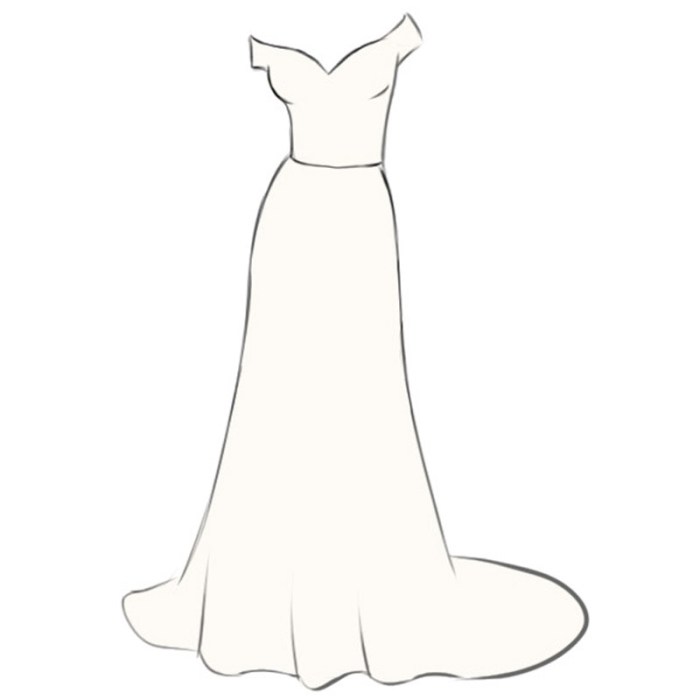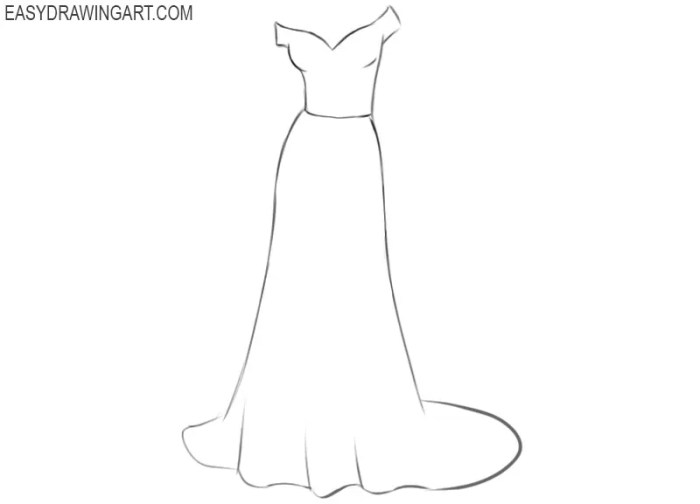Understanding Basic Shapes and Structure of a Wedding Dress
How to draw a wedding dress – Before diving into the intricate details, it’s crucial to grasp the foundational geometric shapes that underpin any wedding dress design. Understanding these building blocks simplifies the process of sketching various styles and allows for greater creativity.
Basic Geometric Shapes in Wedding Dress Design
Most wedding dress silhouettes can be deconstructed into a combination of circles, triangles, and rectangles. A simple circle might represent the skirt’s fullness in a ballgown, while triangles can define the bodice’s shape and the A-line skirt’s flare. Rectangles form the basis of structured bodices and straight skirts. These shapes, when skillfully combined, create the diverse range of wedding dress styles.
Combining Basic Shapes to Create Silhouettes
The process of creating different silhouettes involves manipulating and combining these basic shapes. For instance, an A-line dress combines a triangle (the skirt) with a rectangle or a slightly curved shape (the bodice). A ballgown uses a large circle for the skirt and a smaller rectangle or a modified triangle for the bodice. A mermaid dress utilizes a combination of a rectangle or a close-fitting triangle for the upper portion and a gradually widening, bell-shaped curve for the lower part, mimicking the shape of a mermaid’s tail.
Perspective and Proportion in Wedding Dress Sketches
Accurate perspective and proportion are essential for creating realistic and visually appealing sketches. Perspective ensures that the dress appears three-dimensional, while proportion dictates the balance and harmony of its various elements. For example, the waistline should be positioned correctly in relation to the overall height of the figure, and the skirt’s fullness should be appropriately scaled to the bodice. Slight variations in perspective can significantly impact the perceived elegance and realism of the sketch.
Different Wedding Dress Styles
Numerous wedding dress styles cater to diverse preferences and body types. Understanding their key features and suitability helps in selecting the perfect design for a sketch, and for a real-life bride.
Wedding Dress Style Comparison
| Dress Style | Description of Silhouette | Key Features | Sketch Example (Descriptive) |
|---|---|---|---|
| A-Line | Fitted at the shoulders and gradually widening towards the hem, resembling the shape of the letter “A”. | Versatile, flattering on most body types, comfortable for movement. | A narrow bodice smoothly transitioning into a gently flaring skirt, creating a balanced, elegant silhouette. |
| Ballgown | Fitted bodice and a full, voluminous skirt, often with a defined waistline. | Romantic, dramatic, ideal for formal occasions. | A cinched waist accentuates the upper body, leading to a dramatically full, circular skirt that creates a princess-like effect. |
| Mermaid | Fitted from the bodice to the knees or mid-thigh, then flaring out dramatically. | Dramatic, accentuates curves, suitable for confident brides. | A close-fitting silhouette that hugs the body before flaring out dramatically at the knees, resembling a mermaid’s tail. |
| Empire Waist | High waistline just below the bust, with a flowing skirt. | Comfortable, flattering on most body types, romantic and ethereal. | A high waistline creates a long, flowing skirt that starts just below the bust, giving a graceful, flowing appearance. |
| Sheath | Straight, form-fitting silhouette from shoulders to hem. | Sleek, modern, best suited for slimmer body types. | A simple, elegant design that hugs the body closely, emphasizing the figure’s natural shape. |
Suitability of Dress Styles for Various Body Types
The choice of wedding dress style significantly impacts how a bride’s figure is presented. A-line dresses are generally flattering on most body types due to their balanced silhouette. Ballgowns suit those who want to create a dramatic look and can carry the volume. Mermaid styles accentuate curves and are best suited for brides with a defined waist and hips.
Empire waist dresses are comfortable and flattering for various body types, especially those who want to emphasize their upper body. Sheath dresses are best suited for slimmer figures as they hug the body closely.
Fabric and Texture Representation
Effectively depicting fabric textures is key to bringing a wedding dress sketch to life. Different fabrics drape and reflect light differently, and these nuances must be captured in the drawing.
Representing Fabric Textures Through Shading and Line Techniques
Lace can be depicted using fine, detailed lines to create intricate patterns, while satin’s smooth surface can be rendered with smooth, unbroken lines and subtle shading to capture its sheen. Tulle’s delicate texture can be suggested through light, feathery lines and shading that creates a sense of transparency and airiness. The use of hatching and cross-hatching can add depth and texture to the fabric, suggesting the folds and creases.
Sketching a wedding dress involves understanding fabric drape and form. Before you begin, however, it’s helpful to consider the overall style, which is where understanding how to choose a wedding dress comes in; referencing a guide like how to choose a wedding dress can greatly inform your design. This preliminary research will allow you to accurately depict the chosen silhouette and details in your drawing, leading to a more realistic and effective final product.
Visual Guide to Fabric Flow and Drape

Source: easydrawingart.com
A visual guide demonstrating fabric drape would show how different weights of fabrics fall. For example, a heavy satin would have deep, well-defined folds, while a lighter tulle would drape more loosely and softly. The illustrations would clearly show the way the fabric flows and folds, creating realistic and visually appealing representations.
Using Hatching and Cross-Hatching for Texture and Depth
Hatching (parallel lines) and cross-hatching (intersecting lines) are essential techniques for creating texture and depth in a wedding dress drawing. The density and spacing of the lines influence the perceived texture and the intensity of shading. Closely spaced lines suggest darker areas, while wider spacing indicates lighter areas. This technique helps to build form and create a three-dimensional effect on the fabric.
Adding Details and Accessories
Details and accessories elevate a wedding dress sketch from a simple Artikel to a captivating illustration. These elements add personality and reflect the overall style and aesthetic.
Drawing Realistic Details: Beading, Embroidery, and Lace
Beading can be rendered using small dots or carefully placed dashes to mimic the sparkle and texture. Embroidery can be depicted using detailed lines and shading to illustrate the stitches and patterns. Lace patterns require careful attention to detail, with intricate lines to capture the delicate and ornate designs. The level of detail should be consistent with the overall style of the drawing.
Drawing Veils, Headpieces, and Other Accessories
A step-by-step guide on drawing veils might start with a basic shape, then add layers and details to create the illusion of flowing fabric. Headpieces can be drawn using geometric shapes and details such as flowers or jewels. Accessories like gloves, shoes, and jewelry should be drawn with attention to proportion and detail to enhance the overall composition.
Common Wedding Dress Accessories and Their Aesthetic Impact
A list of common accessories might include veils (birdcage, cathedral, blusher), headpieces (tiaras, flower crowns, hairpins), jewelry (necklaces, earrings, bracelets), gloves, shoes, and handbags. The inclusion of these accessories significantly influences the overall aesthetic of the drawing. For example, a long cathedral veil adds drama and elegance, while a simple flower crown creates a more bohemian feel.
Creating a Complete Wedding Dress Illustration
Bringing together all the elements discussed previously results in a comprehensive and visually stunning wedding dress illustration.
Complete Wedding Dress Illustration with Design Choices and Techniques
A complete illustration might depict a ballgown wedding dress with intricate lace detailing on the bodice and a full, flowing skirt made of satin. The bodice could be adorned with delicate beading, and a long, flowing veil could complete the look. The illustration would showcase the use of shading, perspective, and line techniques to create a three-dimensional effect, highlighting the fabric’s texture and the dress’s overall form.
The caption would detail the design choices, emphasizing the use of geometric shapes to create the silhouette, the techniques used to render the fabric textures, and the overall aesthetic.
Use of Light and Shadow for Three-Dimensional Effect, How to draw a wedding dress
Strategic use of light and shadow is crucial for creating a three-dimensional effect. Light sources should be clearly defined, with shadows realistically cast to create depth and volume. This enhances the realism and visual appeal of the illustration, making the dress appear lifelike.
Steps Involved in Creating the Final Artwork

Source: easydrawingart.com
The process would begin with a basic sketch outlining the silhouette and key features. Details such as lace, beading, and other embellishments would be added progressively. Shading and highlighting would then be incorporated to create texture and depth. Finally, the illustration would be refined and finalized, paying close attention to the overall composition and visual harmony.
Top FAQs: How To Draw A Wedding Dress
What kind of paper is best for drawing wedding dresses?
Smooth, heavyweight drawing paper or illustration board is ideal for detailed work. Avoid highly textured paper which can make fine details difficult.
What pencils should I use?
A range of pencils (H for light sketching, B for darker shading) is recommended to achieve varied tones and details. Consider using a kneaded eraser for precise corrections.
How can I improve my shading techniques?
Practice observing light and shadow on real fabrics. Start with light layers of shading and gradually build up darker tones. Experiment with different shading techniques like hatching, cross-hatching, and blending.
Where can I find inspiration for wedding dress designs?
Browse bridal magazines, wedding websites, and Pinterest for a wealth of inspiration. Look at runway shows and designer collections for innovative styles and details.
